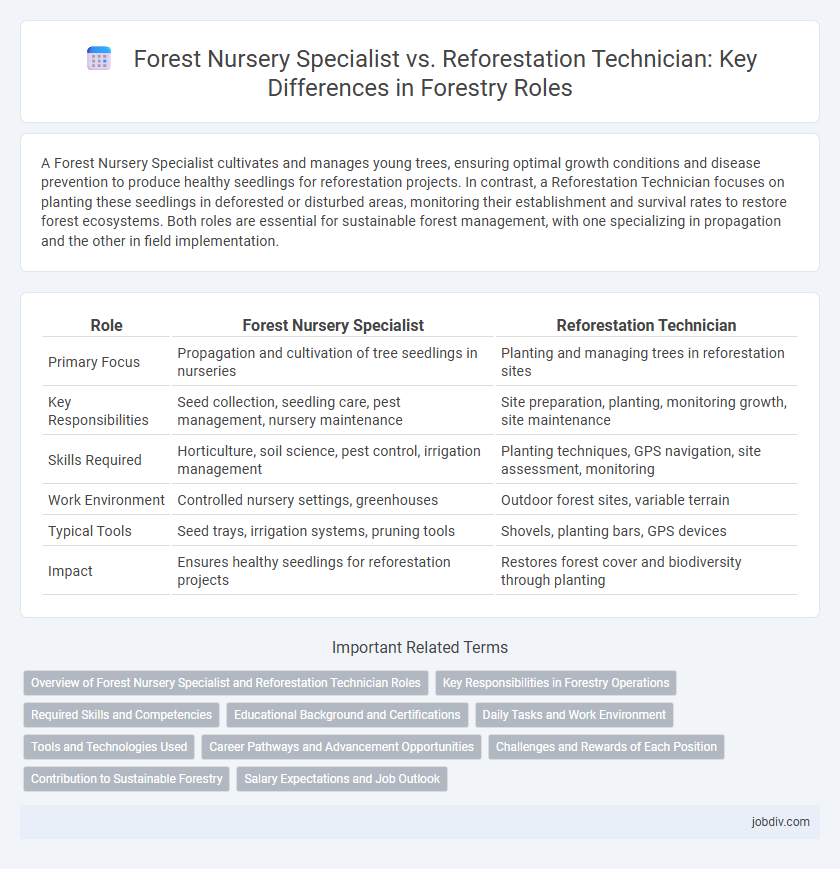A Forest Nursery Specialist cultivates and manages young trees, ensuring optimal growth conditions and disease prevention to produce healthy seedlings for reforestation projects. In contrast, a Reforestation Technician focuses on planting these seedlings in deforested or disturbed areas, monitoring their establishment and survival rates to restore forest ecosystems. Both roles are essential for sustainable forest management, with one specializing in propagation and the other in field implementation.
Table of Comparison
| Role | Forest Nursery Specialist | Reforestation Technician |
|---|---|---|
| Primary Focus | Propagation and cultivation of tree seedlings in nurseries | Planting and managing trees in reforestation sites |
| Key Responsibilities | Seed collection, seedling care, pest management, nursery maintenance | Site preparation, planting, monitoring growth, site maintenance |
| Skills Required | Horticulture, soil science, pest control, irrigation management | Planting techniques, GPS navigation, site assessment, monitoring |
| Work Environment | Controlled nursery settings, greenhouses | Outdoor forest sites, variable terrain |
| Typical Tools | Seed trays, irrigation systems, pruning tools | Shovels, planting bars, GPS devices |
| Impact | Ensures healthy seedlings for reforestation projects | Restores forest cover and biodiversity through planting |
Overview of Forest Nursery Specialist and Reforestation Technician Roles
Forest Nursery Specialists manage the propagation and cultivation of tree seedlings in controlled environments, ensuring genetic diversity and seedling health for future forest growth. Reforestation Technicians focus on planting and maintaining these seedlings in deforested or degraded forest areas to restore ecosystems and improve biodiversity. Both roles require expertise in silviculture, but specialists typically work in nurseries while technicians operate primarily in field conditions.
Key Responsibilities in Forestry Operations
Forest Nursery Specialists focus on cultivating and managing young trees in controlled environments, ensuring optimal growth conditions, pest management, and seedling quality for reforestation projects. Reforestation Technicians are responsible for planting, monitoring, and maintaining trees in natural and disturbed forest sites, facilitating ecosystem restoration and biodiversity conservation. Both roles collaborate to support sustainable forestry operations, with emphasis on site preparation, seedling selection, and long-term forest health.
Required Skills and Competencies
Forest Nursery Specialists require expertise in seed collection, propagation techniques, and pest management to cultivate healthy seedlings. Reforestation Technicians must demonstrate skills in site preparation, planting methods, and monitoring tree growth to ensure successful forest restoration. Both roles demand knowledge of local ecosystems and proficiency in using field equipment and data recording tools.
Educational Background and Certifications
Forest Nursery Specialists typically hold degrees in forestry, horticulture, or environmental science, emphasizing propagation and nursery management skills. Reforestation Technicians often have training in natural resource management or forestry technology, with certifications such as the Certified Forester credential or chainsaw operation licenses enhancing fieldwork capabilities. Both roles benefit from specialized certifications in pest management, seed collection, and tree planting techniques to optimize reforestation success.
Daily Tasks and Work Environment
Forest Nursery Specialists primarily manage seedling propagation, monitor plant health, and ensure optimal growth conditions in controlled nursery environments. Reforestation Technicians focus on planting trees, site preparation, and maintenance of reforested areas, often working outdoors in diverse weather conditions. While Nursery Specialists operate in greenhouses or nurseries, Reforestation Technicians spend significant time in forests, navigating rough terrains.
Tools and Technologies Used
Forest Nursery Specialists utilize advanced seed germination chambers, automated irrigation systems, and nutrient delivery technologies to optimize sapling growth and health. Reforestation Technicians employ GPS mapping tools, drone surveillance, and mechanical tree planters to efficiently restore deforested areas and monitor ecosystem recovery. Both roles integrate data management software to track plantation progress, but their specialized tools reflect distinct stages of forest regeneration.
Career Pathways and Advancement Opportunities
Forest Nursery Specialists typically begin their careers managing seed collection, propagation, and seedling care, progressing to roles such as nursery manager or forest regeneration coordinator with experience. Reforestation Technicians often start in fieldwork, assisting with tree planting and site preparation, advancing to supervisory or project management positions in restoration or forest management. Both career paths offer opportunities for specialization in silviculture, forest ecology, and resource management, with higher education and certifications enhancing advancement potential.
Challenges and Rewards of Each Position
Forest Nursery Specialists face challenges such as managing plant propagation, disease control, and maintaining optimal growing conditions to ensure high-quality seedlings. Reforestation Technicians encounter difficulties in planting seedlings across varied terrains, monitoring survival rates, and dealing with environmental factors like weather and soil degradation. Both roles offer rewards through contributing to ecosystem restoration, biodiversity enhancement, and combating climate change impacts.
Contribution to Sustainable Forestry
Forest Nursery Specialists enhance sustainable forestry by producing high-quality seedlings adapted to local ecosystems, ensuring genetic diversity and resilience in reforestation projects. Reforestation Technicians implement planting strategies and monitor site conditions, promoting forest regeneration and ecosystem restoration. Both roles collaboratively contribute to maintaining forest health, carbon sequestration, and long-term biodiversity conservation.
Salary Expectations and Job Outlook
Forest Nursery Specialists typically earn between $35,000 and $50,000 annually, reflecting their specialized skills in seedling cultivation and nursery management. Reforestation Technicians have a salary range from $30,000 to $45,000, often influenced by fieldwork intensity and geographic location. Both roles experience steady job growth driven by increasing demand for sustainable forestry practices and reforestation projects worldwide.
Forest Nursery Specialist vs Reforestation Technician Infographic

 jobdiv.com
jobdiv.com